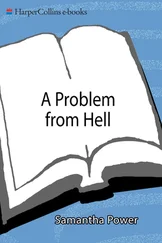THE EDUCATION OF AN IDEALIST


William Collins
An imprint of HarperCollins Publishers
1 London Bridge Street
London SE1 9GF
WilliamCollinsBooks.com
HarperCollins Publishers
1st Floor, Watermarque Building, Ringsend Road
Dublin 4, Ireland
This eBook first published in Great Britain by William Collins in 2019
Copyright © Samantha Power 2019
Cover photograph by Geoffrey W. King
Samantha Power asserts the moral right to be identified as the author of this work
The opinions and characterizations in this book are those of the author and do not necessarily represent those of the US government.
A catalogue record for this book is available from the British Library
All rights reserved under International and Pan-American Copyright Conventions. By payment of the required fees, you have been granted the non-exclusive, non-transferable right to access and read the text of this e-book on-screen. No part of this text may be reproduced, transmitted, down-loaded, decompiled, reverse engineered, or stored in or introduced into any information storage and retrieval system, in any form or by any means, whether electronic or mechanical, now known or hereinafter invented, without the express written permission of HarperCollins
Source ISBN: 9780008274924
Ebook Edition © August 2019 ISBN: 9780008274931
Version: 2021-02-03
For Cass, Declan, and Rían
CONTENTS
Cover
Title Page
Copyright
Dedication
Preface
PART ONE
1. Ireland
2. America
3. Loss
4. Dignity
5. Tank Man
6. Doers
7. Risk
8. Hearts of Darkness
9. “Tell Clinton”
10. The Secret to a Long Life
11. “Go Remember”
12. “A Problem from Hell”
13. Upstanders
14. Going to Washington
15. The Bat Cave
16. Yes We Can
17. Monster
18. Victory
PART TWO
19. No Manual
20. Can We Go Home Now?
21. April 24 th
22. Turnaround
23. Toolbox
24. Revolutions
25. All Necessary Measures
26. Let’s Pray They Accomplish Something
27. One Shot
28. “Can’t Be Both”
29. The Red Line
30. “Chemical Weapons Were Used”
31. When America Sneezes
32. Upside-Down Land
33. Us and Them
34. Freedom from Fear
35. Lean On
36. Toussaint
37. The Golden Door
38. Exit, Voice, Loyalty
39. Shrink the Change
40. The End
Afterword
Picture Section
Footnotes
Notes
Index
Acknowledgments
About the Author
Also by Samantha Power
About the Publisher
On a bright Saturday in September of 2013, I was sitting in a crowded diner in midtown Manhattan with my husband, Cass, and our kids, four-year-old Declan and one-year-old Rían. My cell phone rang. The White House switchboard was on the line: “Ambassador Power, please hold for the President of the United States.”
I took two long sips of water and walked out of the restaurant’s clamor toward the corner of 50th and Lexington.
I had first met Barack Obama eight years before, when he was a newly elected US senator. Although he was already considered a bright young star in American politics, I would not have predicted then that within a few short years he would become president. And I would have found it unbelievable that I—an unmarried Irish immigrant, obsessive sports fan, journalist, and human rights activist who had not served a day in government—would, within that same period, gain a husband and two children and be named United States Ambassador to the United Nations.
And yet there I was, with a security detail hovering, about to confer with the President while my family sat nearby.
Obama was not calling for a Saturday-afternoon chat. Syrian president Bashar al-Assad had recently unleashed chemical weapons against his own citizens, killing 1,400 people, including more than 400 children. This atrocity crossed the “red line” that the President had drawn when he threatened the Assad regime with “enormous consequences” if it used chemical weapons. In response, Obama had initially decided to order air strikes in Syria, but Congress—and most of the American public—had not supported him.
Then the unforeseen happened: Russian president Vladimir Putin, Assad’s ally, offered to work with the United States to destroy Syria’s large chemical weapons stockpile.
Locking down the specifics was left to me and my Russian counterpart at the UN. If we failed to negotiate a Security Council resolution, President Obama did not have a Plan B.
“Hey!” Obama said when he came on the line. Despite the gravity of the situation, he used the same airy inflection as when we first met in 2005.
I had only become UN ambassador the previous month, and Obama understood that I was facing a high-pressure diplomatic assignment. He was checking in to be sure we were on the same page.
“I just want you to know I have complete confidence in you,” he said.
I started to thank him.
“But …” Obama interrupted.
At that moment I did not need a “but.”
“But in these negotiations with the Russians,” he continued, “I want to make sure you don’t overshoot the runway.”
The Syrian government was notorious for unspeakable acts of savagery against its own people, and Obama knew I was skeptical that Assad would ever relinquish his chemical weapons. He was concerned I would demand too much from the Russians and cause them to walk away.
“But don’t undershoot the runway either,” he quickly added.
“Yes, Mr. President,” I said.
We hung up and I began walking back toward the diner, security agents in tow.
Don’t overshoot. Don’t undershoot. Looking up to the cloudless sky, I found myself wondering something more fundamental: “Where the hell is the runway?”
I HAD SPENT DECADES thinking about moments such as this, critical junctures in American foreign policy where lives were at stake. Studying the manual, however, is not the same as flying.
In 2002, I had published my first book, “ A Problem from Hell ”: America and the Age of Genocide . In the book, I criticized US officials for doing too little to stop the major genocides of the twentieth century. Now I found myself in the President’s cabinet as the Syrian regime was murdering hundreds of thousands of its own people.
“What would the old Samantha Power say to the current Samantha Power?” reporters often asked. “How does the author of a book on atrocities defend the US government’s inaction in the face of mass murder in Syria?”
My standard answer rejected the implication that my past and present selves were in conflict. “The old and new Samantha know each other quite well,” I would reply. “They talk all the time. And they agree …”
The full answer, of course, was more complicated.
I had gone from being an outsider to an insider—from being a critic of American foreign policy to a leading representative of the United States on the world stage. From within government, I was able to help spur actions that improved people’s lives. And yet we were failing to stop the carnage in Syria. I was at risk of falling prey to the same mode of rationalization I had assailed as an activist.
Читать дальше














